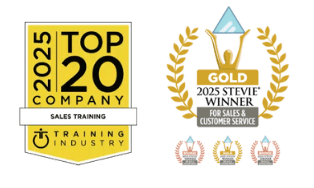The current business to business sales environment is riddled with a mediocre approach and thinking. The average corporate sales presentation is close to 45 slides or pages, and worse, the first five are about your company. Your client contact does not care about your number of employees, geographic locations, mission statement, or company revenues.
There are two questions a client decision maker is concerned about when meeting you:
- I wonder if they can help my business. This was the reason they took the meeting to begin with. They have hopes you are able to bring Thought Leadership / ideas that will affect important initiatives or metrics.
- I wonder if they can help me. IF you pass the test the first question poses, they now see you as an asset they can potentially leverage to achieve their agenda.
A huge error continually made in the sales profession is not taking the time to understand the client’s business environment through researching the challenges or opportunities your client’s company may be dealing with.
Ask yourself the question: “What has recently changed within my client’s industry that is creating either opportunity or potential harm?” Are there new regulations, government focus, economic change, social norm emphasis, disruptive technologies, or environmental concerns affecting their industry?
Once you understand the changes affecting their industry – the key is to transition your opinion into what they could potentially do about it. What ideas can you generate? How can you help them take advantage of the shift or mitigate the potential risk? What can you bring that would be beneficial to them?
Once you have done some research online and have identified the factors changing, as well as the ideas you have, the most important part of the story comes into play – how can your idea affect them?
Can you help them realize greater revenue and margin? Can you provide savings and cycle time reduction? Can you help them win market share or reduce their customer churn? Make a list of the outcomes your idea can impact and start estimating the amount you believe you can affect. For example, “I believe we can reduce your client project cycle time by 15-20%, which immediately will increase your profit margin per project and enhance your reputation in the market.”
You have now got the basics of your story. You have identified the important changes within their industry, generated several ideas, and listed the outcomes you can create if your client chooses to explore your idea. Now you need to engage your audience.
Review your outcomes. Who would be interested in hearing about how you can reduce 25%+ of waste product in the manufacturing plant? Create 20% greater capacity for manufacturing volume? Reduce employee turn-over or worker injury? Free “trapped capital” in the form of savings and re-investment? Improve margin and net profit? The outcomes will point you to the right people. In many instances we realize we may have been talking to the wrong people in the past. Our new audience is at a higher level. We may find we have expanded our audience to include titles we have never spoken with before. In essence, you may have created a “green field” of new titles!
Get their attention. How are you going to “cut through the noise?” LinkedIn is an excellent resource but use it wisely. NEVER simply send a message asking to connect. Make the note personal – ALWAYS. Share some of your ideas and give them a reason to want to connect with you. Otherwise, you have revealed yourself as someone not worthy of their attention. The same is true for leaving voice messages or sending emails, which are often used ineffectively. You need to “tease” them to want to explore the idea with you. You need to “sell them” on why 30 minutes is worth the investment of their time.
Make the most of your meeting. DO NOT engage in using your time to present “Death by PowerPoint.” You promised them value in the form of an idea and that is what you need to deliver. It is NOT a presentation. It is your Thought Leadership. You have a story to share which will evolve into a discussion.
Think about how you would approach a friend or colleague with an idea you believed in. You would be primarily concerned with sharing your idea, conveying your desire to help, and engaging in a relaxed conversation. This is no different. You are there to sell your IDEA. You are there to sell the NEXT STEPS in exploring the idea. It is a natural way of engagement where you are seeking to help.
The approach works. It is valued by senior client contacts and they will appreciate your manner of sharing your idea. It will elevate your credibility and result in greater confidence, improved poise, enhanced business connection, and ultimately – more opportunity and revenue.
Personal Challenge:
Review your current presentations and contact messaging. Are you more focused on what you are trying to achieve or the benefits a client can receive from your ideas? Measure your current approach against the advice provided in the article and revise it to reflect on how you can help your client achieve greater value from your Thought Leadership.




